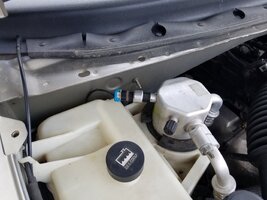+1 Here -^- ...and THIS is WHY...
If your SLT is equipped with a Front and Rear Cooling system...
The entire charge of R-134A for the system should not exceed 3.00 Lbs. There is no accurate way to know what the A/C system is doing if you cannot graphically see BOTH sides of the system ...both statically, when the system is turned off and the R-134A will redistribute itself and appear balanced and when it is running. Therefor the Prime Tool made for these purposes is that of an Auto A/C Manifold Gauge Set. It gets attached to BOTH the High Pressure Liquid Line
(RED) Side and the Low Pressure
(BLUE) Returning Vapor Line Side of the system. Once the Engine is running and the A/C is turned on... the Low Pressure Side should drop down to around 70 - 80 PSI and the High Pressure Side should pressurize upwards to around 250-300 PSI if the system is sound and the A/C Compressor and line hardware are operating Nominally.
One of the things that can cause the A/C to appear to function normally for the First (5) Minutes ...and then Blow Hot Air through the Vents will occur
if there is any Moisture in the Lines... especially if there is a Leak in the Low Side Lines that will vacuum in Ambient Air that naturally includes Atmospheric Water Vapor that can then travel through the A/C system. When the in-compressible Water Molecules condense inside of the smaller capillary lines of the Evaporator-Expansion Coil ...it can "Flash-Freeze Solid" and plug up the those narrow Liquid Line Capillary Passages and prevent the Refrigerant from continuing on through the system. Hence, there will be the sudden stoppage of the "Cool Air" as soon as the Evaporator Capillary Section is Frozen Up...
Weird? ...Yes... But THIS is exactly how it fails.... for a while ...at least until that Frozen Water Blockage Melts ...and then the Cycle repeats itself over and over.
Another Blocking Point can occur happens when the Orifice Tube becomes so completely clogged with junk and dirt from the system internals as to preclude the smooth passage of R-134A through the system. So when either of these two conditions prevail... (or BOTH) then the Hot, Liquefied R-134A exiting the Condenser Coil will begin to back up inside of the Liquid Line side of the system and create a "High Head Pressure" condition in the A/C Compressor... possibly damaging the internal components and seals and cause the Compressor to fail before its time.
The only absolute way in which to know Exactly how much R-134A is presently inside of the system ...is to Recover it as BOTH Vapor and Liquid in a proper, empty and vacuumed A/C Recovery Cylinder. Afterwards, the Recovery Cylinder must be weighed... and the "TARE" weight of the Cylinder gets Subtracted from the Total Weight of that cylinder AND the contents of the recovered R-134A.
Then the theoretically clean system should be vacuumed down to around 25 Microns using a Harbor Freight A/C Two Stage Scroll Vacuum Pump filled to the right level with Recovery Oil in order to completely remove all of that contaminating Moisture... Dirt ...and Non-Condensable Gasses. If the system can hold a decent vacuum without having the needle on the Vacuum Gauge rise above 29" of Mercury and remain below "O" PSIG (14.7 PSI) ... then the 3.00 Lbs of R-134A can be gradually introduced to the point where the Low Pressure Cut-Off Switch stays on and the A/C Compressor can engage and remain running until the balance of the 3.00 Lbs of R-134A is allowed to enter and top off the system. The BEST way to ensure that the Schrader Valves in the Service Ports and the Green "O"Rings will seal up tight and remain so for the life of the system... is to treat them during re-assembly using NYLOG (Blue or Red...It does not Matter) available from Amazon) Here is a video to introduce the stuff to you:
THIS Charging Action should only be done via the Low Side Service Port... and Never as a Pure Liquid by deliberately turning the Can(s) of R-134A UPSIDE DOWN, lest the liquid refrigerant be ingested by the running A/C Compressor ...and Destroy it. The A/C Compressor is designed ONLY to compress R-134A as a GAS... and discharge it as a Hot Liquid after passing through the Condenser Coil... but NO LIQUID REFRIGERANT should ever enter the Low Side of the System during the Charging of R-134A.
So as you can see... there is much to be done to diagnose and correct problems that can occur in so many places within the A/C System that require the Knowledge ...the Skill Set and the Specialty Tools to isolate the problems and perform repairs on any and all of these possible failure points. You simply cannot get there by viewing the "Gauge" on a Can of R-134A and determine these issues.



 Just don't over fill, or you will be fixing it all over again.
Just don't over fill, or you will be fixing it all over again. Compressor clutch not spinning... Will take it in next week.
Compressor clutch not spinning... Will take it in next week. ...I just woke up and didn't want the OP to be on the hook for a compressor if he didn't need it yet.
...I just woke up and didn't want the OP to be on the hook for a compressor if he didn't need it yet.